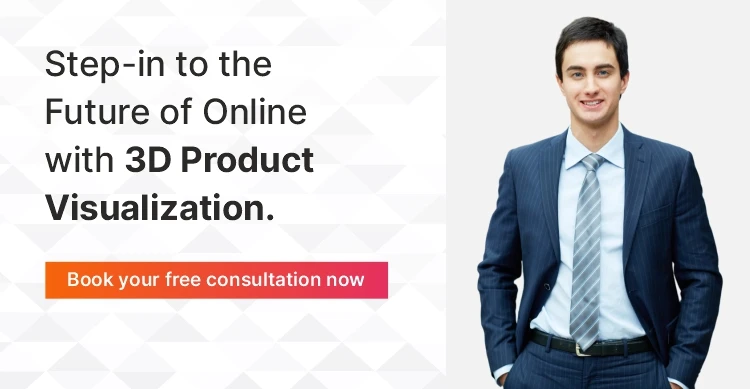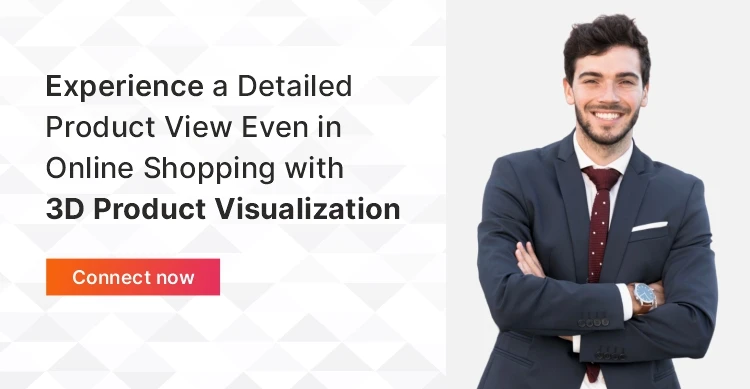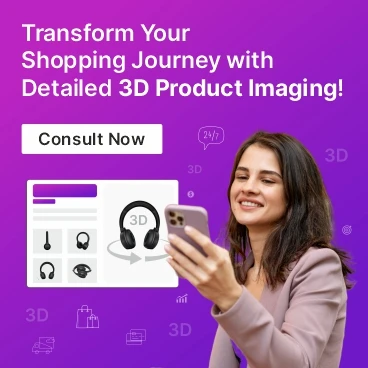Transforming the Shopping Experience with 3D Product Imaging
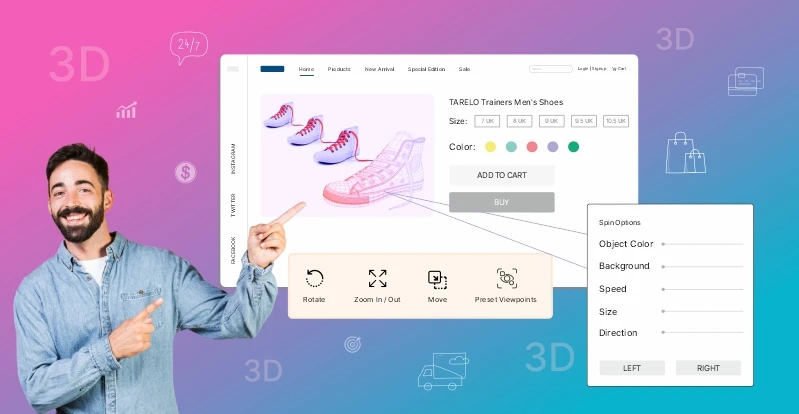
Customers’ perceptions of products have shifted due to their changing behavior. They now expect to see detailed images of every product.
But, because of the restrictions in the online business model, it is important to do this process. This is when the need for 3D product view, 360-degree view, AR, and VR becomes essential.
As per the Grand View research, “ The global visualization and 3D rendering market is expected to reach USD 5.63 billion by 2025.”
These technologies have completely changed the end-user’s view of the product. It further helps them to experience the product market in a better manner that boosts their shopping experience. Besides, these features help to stand out from the crowd by replacing the traditional product images.
Today, we will discuss the key benefits of 3D product imaging and how it’s majorly changing customer retention. We will also investigate the transformation of users’ purchasing experiences approached by 3D and AR product representation.
Why Choose 3D Product Envision?
3D product view enriches the online buying experience by changing how people interact with their products. Instead of static visuals, this technology provides an immersive and interactive journey.
Shoppers can inspect things from every angle, zoom in for a closer look, and interact with various features. 3D view creates confidence and drives conversions by bridging the physical and online retail gap.
Nike, a leader in this field, has included 3D product views into their eCommerce platform. Customers can use 3D models to interact with products. They can rotate, zoom, and connect with the products with ease. This surpasses the limitations of regular photos.
This increased interaction created a meaningful connection between customers and the products. It’s demonstrating the changing power of 3D product view in altering the future of retail.
The Benefit of 3D Product Imaging
The online eCommerce industry encounters various challenges, specifically with customer satisfaction. Implementation of 3D product imaging can solve many problems related to customer satisfaction. Let’s explore the key benefit of 3D product imaging below:
Product Configurator
In today’s online shopping business, using 3D product configurators is critical for improving the customer experience. Customers can use these advanced tools to customize various aspects of their chosen products, such as shape, size, and colour. This level of personalization improves the shopping experience and addresses the growing demand for individuality in consumer preferences.
Businesses can involve customers in the design process using 3D product configurators. It will allow them to personalize their products for a better experience. This interactive customization forges a strong bond between the customer and the product, increasing satisfaction and loyalty.
Let’s take the example of a clothing brand that can use a 3D product configurator to help its customers customise their clothes. Users can change the fabric, colours, and styles, creating a virtual fitting room experience. It facilitates customer decision-making and makes shopping more enjoyable.
Using 3D product configurators in eCommerce technology allows businesses to stand out and cater to changing consumer preferences. This contemporary approach distinguishes firms in a competitive market and increases customer engagement and satisfaction.
Get Product Silo Images
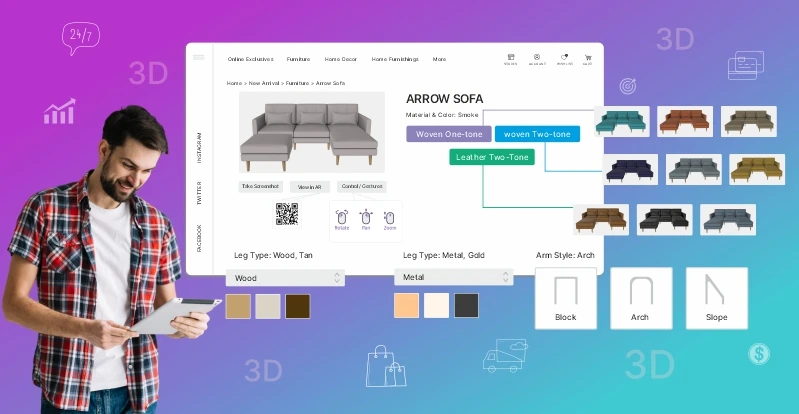
Product silo images created with realistic 3D modelling have numerous advantages over traditional photography for representing products. They display different types of products from various angles and materials, providing an immersive digital experience that exceeds standard photographs’ limitations.
This method combines visual appeal, efficiency, speed, and cost-effectiveness. Product silo images outperform traditional product photography by showcasing items against a clean white background. These versatile images represent the product, creating an engaging visual experience for online visitors.
Let’s take the example of a furniture business; integrating 3D images into an online furniture catalogue improves the customer experience significantly. With these lifelike renderings, customers can view furniture items from various angles, providing a detailed and immersive experience.
Prospective consumers can also visually place the 3D furniture in their own spaces. It will give them a sense of how it will look in their specific environment. Adopting 3D graphics will reduce the need for actual samples, saving money on inventory and showrooms. Customers can virtually try out the furniture before purchasing, enhancing their confidence and decreasing returns.
This improves the customer experience overall. The customer can use 3D images to view and analyse the sofa from various angles and evaluate its design and size. They can also make use of augmented reality.
It will help to create a visually appealing and distinct brand image that resonates with customers online by presenting high-quality product silo photos. This immersive experience transcends traditional photography’s limitations and establishes a more robust customer bond.
360° Rotating Video
Use a 360-degree rotating video to increase the authenticity of your products. This interactive experience goes above the boundaries of static photos by allowing for dynamic lighting and shading effects. The rotating video delivers a complete image of your product, such as a chair, by collecting multiple views.
Consider a 3D representation of the chair, including the different views. This method can alter your marketing approach by giving customers a thorough and compelling view of your business. Elevate your presentation, fascinate your audience, and immerse them in a realistic interaction with your product.
According to an Adobe survey, 91% of online customers say a 360-degree product viewer is a must-have.
For example, a jewellery business can use this tool to show the product in detail to the end-users. It will help give a better product experience, and that will help them get higher conversion.
Get Personalized Experiences
Personal encounters are the most essential factors in determining consumer satisfaction. Customers are prepared to spend extra for a 3D view, which is becoming increasingly vital in creating amazing shopping experiences. The core benefit of 3D envisioning is the ability to observe things from all angles and even alter them with different colours.
Customers have unparalleled control over the product with the help of a 3D view. It goes beyond regular shopping and provides an immersive experience where users actively participate rather than browse.
Enhance your customer experience so that they can view and form their perception of the product. It’s developing a more robust connection that extends beyond the transaction. Welcome to a new era of client contact, in which 3D view takes center stage.
Real-time 3D Product Viewer
Explore the future of online business with real-time interactive 3D models that go beyond traditional rendering. Customers can actively view the different variations of the products by rotating, changing colours, and modifying elements in motion.
Customers can navigate the product and even place a 3D model in an augmented reality app using this viewer. Augmented Reality (AR) technology enhances the experience by allowing users to integrate the product seamlessly into their real-world environment. This enables people to see how the product appears and fits in their environment before purchasing it because of advances in 3D view technologies.
Built Trust with Your Customers
Being authentic and displaying your product as it truly is is critical in creating consumer confidence. 3D envision aids this effort by allowing clients to study products from all angles. Customers trust transparency, feel informed, and are less likely to be disappointed with their purchase.
According to a recent study, “3D graphics increase customer engagement by 66% when compared to traditional 2D images”.
Investing in 3D imagesis a strategic decision to enhance trust in your product and company. Customers will be loyal and make repeat purchases if you provide an accurate and complete portrayal of your services. 3D product visuals help the eCommerce website develop long-term partnerships with the end-users based on transparency.
Marketing Strategies for Improving Customer Experience with AR and 3D
Interactive Product Imaging
Customers can virtually experience and interact with products before purchasing using augmented reality (AR) and 3D technologies. This hands-on approach increases their understanding of the product, confidence in decision-making, and overall satisfaction.
Virtual-try on Option
Virtual try-on experiences use augmented reality (AR) to allow customers to make better decisions about their product purchases. It helps to try the product before consumption, reducing returns, and increasing customer satisfaction.
According to the study, “67% of consumers have used or expressed interest in using virtual try-on technology.”
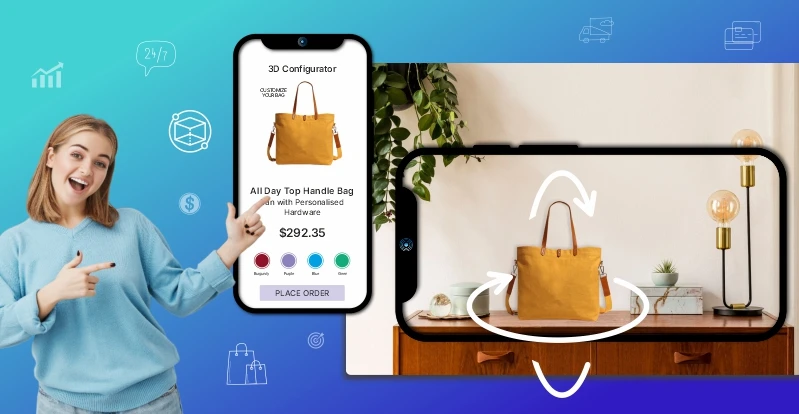
AR-based Guide for End-users
AR is a new concept for customers, so they often get confused about its usage. However detailed tutorials and support can provide step-by-step augmented reality instructions for assembling products. It can also help them troubleshoot issues and operate complex devices. This reduces the need for traditional customer support while providing customers with a more efficient and satisfying experience.
Use of AR in Marketing Campaign
To ensure a great shopping journey, businesses can use the power of AR. It will enhance marketing campaigns, which entail building strategies to captivate the customer base in new ways. Creating advertisements, interactive catalogues, or gamified experiences that highlight your products is an example of this. Not only does it help to drive better sales, but it also provides a memorable experience to build a bond between your brand and customers.
Effective Email Marketing
Email designs that incorporate 3D graphics can be more engaging and visually appealing. This can help recipients’ attention in crowded inboxes and create a more interactive experience.
Refined illustrations elevate the content and generate interest in the highlighted products or services. This creative approach distinguishes your brand and leaves an indelible impression on your target audience.
The improved connectivity of these emails leads to higher click-through rates and fosters a deeper connection with recipients. It drives their curiosity and interest in your products.
Boost User Engagement with 3D Experiences
Including a 3D view in online shopping reduces bounce rates and increases customer involvement. Customers can thoroughly examine products, visualize customization options, and view various angles with the help of 3D models. It helps to increase engagement and leads to longer website visits, which reduces bounce rates.
The advantages of 3D rendering extend beyond increased customer engagement. With accurate and detailed product representations customers can visualize and connect with the products in a better manner. This understanding fosters trust and confidence, increasing the likelihood of purchasing.
Furthermore, interactive 3D modelling for product customization creates a more engaging and personalized shopping experience. It encourages customers to spend more time on the website design of products based on their preferences.
3D envisioning in online retail improves customization and attracts customer attention. It also increases trust and satisfaction, which leads to lower bounce rates and a higher likelihood of successful conversions.
Success Story
Many eCommerce businesses have already chosen 3D product imaging and AR solutions for enhancing their business standard; let’s explore a few of them below:
IKEA
Ikea has set a different standard for its customers by enhancing product imaging to the next level. They have used AR for many years to ensure an excellent preview for their customers. The users can get the actual view of the furniture on their desktop and smartphone before consuming it. It allows the end-customers to experience the product through their try-on option, giving them a better experience about the product even in an online purchase.
Besides the AR technology, they also offer 3D product views for every product. This helps them view the product from a different angle from the website and mobile apps. It drives a better product vision, ultimately leading to higher sales growth. IKEA uses AR and 3D imaging to improve their online shopping experience and stand out in the competitive eCommerce industry.
Nike
Nike is another great example of 3D product imaging and AR implementation. They have used this technology to improve their digital marketing system. They began using 3D printing technology in their footwear production, resulting in improved product views. Later, they employ augmented reality (AR) technology to aid in shoe fitting.
It helps offer the end-users a better experience by scanning a person’s foot and measuring its size and shape. The brand’s software can offer proper shoe sizes and allow customers to select their preferred patterns and colours.
Nike uses augmented reality and 3D models to build its marketing strategy. Customers can share their personalized products on social media, which helps boost their satisfaction. This feature increases user engagement by letting potential consumers see and feel the shoes. All these implementations have helped them boost their conversion rate and made them the market leader for sports shoes.
Final Words
Customer expectation is growing day by day, specifically in online stores. The end-users have created different expectations from the retailers. To offer a better experience, customers are demanding an upgraded view and product understanding. The implementation of AR, VR, and 360-degree views of products has reshaped the way customers envision their products.
The leading business has already implemented this technology to have better prospects. IKEA, Amazon, and Nike are the most common examples. Hence, investing in this technology is a core necessity for new-age retail businesses.
Connecting with expert professionals can help to implement this technology and ensure a great outcome. Modern technology is the future of retail; choose wisely and secure a profitable business outcome.
